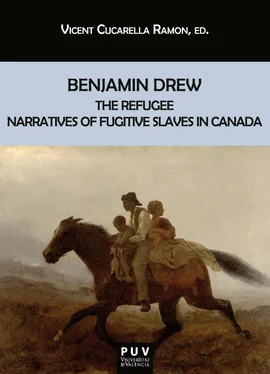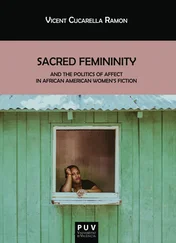Another relevant publication that Shadd undertook was the foundation, in 1853, of an anti-slavery paper, called The Provincial Freeman . The paper’s slogan was “Devoted to antislavery, temperance and general literature” and it encapsulates the ideological messages it conveyed and spread. Shadd’s editorship of the periodical alone became a milestone as it cued change, marking an important moment in publishing and Black representation in the mid-nineteenth century. In all certainty, “Shadd’s irrepressible drive for freedom and active black self-transformation finally also produced a kind of ideologiekritik that reflected on the mental barriers to freedom among free blacks in Canada” (Siemerling 113). The Provincial Freeman needs to be praised also because it stood for the reality and adversities of Blacks whilst it offered an influential stage for reflection on Black specificity and transformation under the conditions of freedom in Canada. The periodical touched upon the issues that were relevant for the daily lives of Black people in Canada (West) and for the cross-border abolitionist movement. Among them, temperance was a leading one. In fact, from the beginnings of abolitionism, temperance was a required practice and disposition and that is why Shadd explicitly advocated: “The planned black settlements in the province either required or recommended temperance. In communities throughout Canada West, local blacks formed societies, like the African Temperance Society of St. Catharines, to promote abstinence from intoxicating beverages” (qtd. in Stewart 46). These Black communities draw this influence from the importance that African American leaders gained in the fight for temperance which, in due course, “helped the emergence of an independent black nationalist movement, and also that Black leaders joined this cause in support of principles such as industry and economy designed to uplift the race” (Bridgen 66). In other words, the temperance movement in the Black Canadian (West) communities adopted and fervently upheld the reformist drive of the temperance movement attached to abolitionism as a way to legitimize their members as proper citizens. As will be exposed later, Benjamin Drew’s collection, following Shadd’s writing and as an example of transnational abolitionist literature, also taps into this important issue as one of the most remarkable goals of the reformist movements that were active in nineteenth-century Black Canada.
Mary Anne Shadd’s influence is noticeable in a highly relevant book that was published in 1855, just a year before the appearance of Drew’s A North-Side View of Slavery: The Refugee, or the Narratives of Fugitive Slaves in Canada and written almost at the same time, by Samuel Ringgold Ward and titled Autobiography of a Fugitive Negro . In it, Ward continues Shadd’s ideological enterprise and his narrative delves into the Black condition and racism in Canada in comparison with the United States. By means of narrating the daily routines and incidents he encounters, Ward walks through Shadd’s paved way and “insists on the continuation of anti-slavery work in Canada in the face of continued support for slavery by a number of groups there” (Siemerling 118). His narrative presents importance elements that anticipate Drew’s own book. In a sort of prequel for the voices of Black Canadians appearing in Drew’s collection, Ward’s narrative is fecund in describing
black meetings, organizations, and the progress of black individuals, and portrays the black communities in Hamilton, St Catharines, London, Chatham, and Buxton. He rejoices over the economic progress in all of the communities visited, finds less-than-expected racism in St Catharines and London, and lauds the economic and educational achievements, absence of begging, and absolute temperance in the Elgin settlement. (Siemerling 119)
Hence, the Black settlements in the Canadian (West) Canaan represent a fertile ground to investigate the crucial role of Canada’s Black communities in a wider and transnational context. For the Black fugitive slave, now turned into a Black Canadian, they are nothing less than the living proof of the rich potential of free Black communities, denied by the pro-slavery forces that kept the United States in their oppressive thrall. As he vehemently asserts: “The coloured people of Canada, as a whole, are the most moral and upright of our race in America” (222). Despite his triumphalist (over)statement, Ward signals the direction that abolitionist thinking was pointing to with regard the Black North American population. In this valuable window of Canada West, taken in the years before 1855 and some time before Drew’s account of fugitive slaves, Ward suggests that the importance of Canada’s Black population as a model ought to make it a central concern for abolitionists because it strengthens their claims and gives rise to a global and more humanitarian defense against the ills of slavery.
Consequently, the cross-border Black communities of Canada West reveal themselves as the locale where the crystallizing debates about abolitionism were taking place. They also showcase the importance of getting their voices heard and their attempt to include themselves in the slave narratives literary trend, a genre that was galvanizing the attention of both abolitionists and North American citizens alike. This is the historical, cultural and intellectual context in which Benjamin Drew tried to include his oral interviews into the abolitionist agenda and, in so doing, participated in reshaping the testimonies of fugitive slaves within the literary imprint of transnational slave narratives.
In defense of Continental Abolitionism through Canadian Narratives of Fugitive Slaves: Benjamin Drew’s The Refugee: Or The Narratives of Fugitives Slaves in Canada
In the mid-1850s and sponsored by the Canadian Anti-Slavery Society, Boston abolitionist Benjamin Drew embarked on a tour throughout Canada West aiming to counter and contest the pro-slavery viewpoint that had been put forth in Nehemiah Adam’s 1854 A South-Side View of Slavery . Adams’s work was propelled by his disgust at the national and international impact of Harriet Beecher Stowe’s Uncle Tom’s Cabin (1852), and in it he intended to respond to Stowe’s novel by offering his own observations of the “true” state of southern slavery. Adams was a pastor of the Essex Street Congregational Church in Boston, who had previously – and publicly – denounced slavery and its consequences. Yet, shortly after its publication and circulation the book earned the reputation of being a proslavery text, or, to a certain extent, a succinct defense of slavery. Indeed, A South-Side View was duly criticized because it avoided advocating for Black emancipation on U.S. soil and for refusing to call for an end to slavery. Rather, it only went as far as to promote reforms and to call for the cessation of what the author partially perceived to be northern meddling in southern matters.
Prior to writing A North-Side View of Slavery: The Refugee, or the Narratives of Fugitive Slaves in Canada , Drew had been in contact with the literary world by means of his participation with a group of writers at The Shade and also because he became the editor of a humor magazine, The Carpet Bag , which had contributors as well-known as Miles O’Really, Artemus Ward or Mark Twain. However, his abolitionist drive took over his journalist exercise and prompted him to take action and travel to the north in order to counteract Adam’s infamous portrayal of slaves. Although some of Adam’s assertions had been heard before, his position as a Boston minister caused a commotion in antebellum antislavery circles. Drew revolved against Adam’s defense of support reconciliation and his belief in the masters’ generous paternalism over their slaves.
Читать дальше











![Benjamin Franklin - Memoirs of Benjamin Franklin; Written by Himself. [Vol. 2 of 2]](/books/747975/benjamin-franklin-memoirs-of-benjamin-franklin-wr-thumb.webp)
![Benjamin Franklin - Memoirs of Benjamin Franklin; Written by Himself. [Vol. 1 of 2]](/books/748053/benjamin-franklin-memoirs-of-benjamin-franklin-wr-thumb.webp)